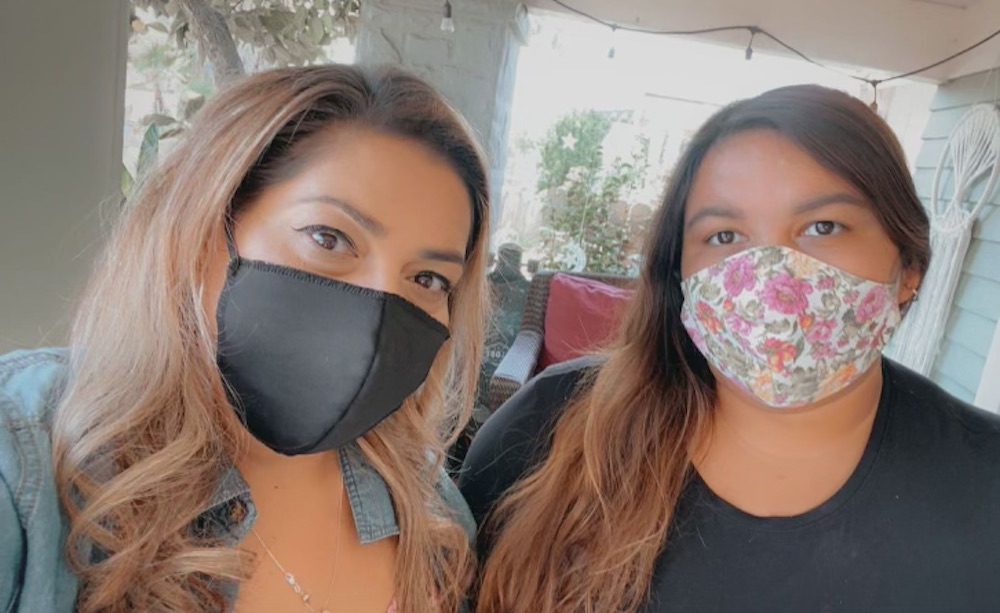 (Photo courtesy of Jazmin Oceguera)
(Photo courtesy of Jazmin Oceguera)
By Jacqueline Ramirez
When Jazmin Oceguera found out her mom had tested positive for COVID-19, she had a feeling she’d be next.
The next day, Oceguera — a 25-year-old Boyle Heights resident — started experiencing symptoms as well and was pretty certain it was COVID. At this point, she began to quarantine herself in her room. Five days after getting tested, she received her positive COVID results.
While some people who test positive can quarantine in hotels or away from family members, that’s not the case for many low-income families.
Oceguera lives in a three-bedroom, 1,300-square-foot rental house in Boyle Heights with her mom, grandmother, brother, sister and her mom’s husband.
Oceguera says she and her mom, Tania Sala, were always cautious and extremely worried about the rest of their family getting sick, especially her grandmother, who’s in her mid-70s and currently undergoing dialysis treatment.
“My brother sleeps in the living room, so there’s not really any other space he could really go,” Oceguera said. “We can’t really afford renting another place, or family members wouldn’t take someone who you know lives in a household of people who have COVID.”
In many low-income families, like those in Boyle Heights, multiple generations live together in a small space, sometimes passing on the virus to others without knowing. According to the Los Angeles Times mapping project of neighborhoods, nearly 100,000 people live in Boyle Heights. The community has a population density of 14,229 residents per square mile, among the highest in the city and county of Los Angeles.
“We know that Latinos are most likely to be non-insured or underinsured, and there’s underlying conditions such as heart disease, diabetes and lung disease which are higher in low-income groups,” said Dr. Maria Anda, an associate professor at the University of Southern California’s Suzanne Dworak-Peck School of Social Work.
She says COVID numbers are disproportionately high in counties such as Los Angeles, Imperial County and the Central Valley, where many work on the frontlines of different types of sectors such as food service, retail, farming and warehousing.
For many, the fear of contracting COVID is real. According to the California Department of Public Health, Latinos account for 55% of the state COVID cases and 46% of deaths. This is disproportionally high compared to the Latino population share of 39%.
While quarantining, it was difficult for Oceguera and her mother to stay away from the rest of the family. The two women stayed out of the kitchen completely. The grandmother and siblings would cook meals and leave the food outside their bedroom doors. Because all of the family members share one bathroom in the house, everyone also had to be extra cautious about cleaning and sanitizing.
“It’s hard,” said Sala, Oceguera’s mom. “I think it affects you mentally, that you can’t really come out of your room.”
After a two-week quarantine, Oceguera and her mother returned to get re-tested. When their results came back positive again, they continued to quarantine for an additional two weeks until they finally received negative results.
“There would be one day where I would feel okay like, this is going to be my last day and tomorrow, I’m going to feel great,” Oceguera said. “And then like, the next hour, I would feel so sick. It was like a big roller coaster.”
Both Oceguera and her mom recovered from COVID. The mother and daughter say they are grateful to have a supportive extended family, and they didn’t require hospitalization. They were also lucky enough to have jobs with benefits, and could use vacation and sick time while they were ill.
But even months later, Oceguera says she sometimes feels the effects and toll it took on her.
“I don’t even have to be walking or running or doing anything,” Oceguera said. “I’ll just be sitting down looking at my phone, and I’ll suddenly feel out of breath.”
But even after all she’s gone through, Oceguera has mixed feelings about the vaccine.
“My plan, for now, is to wait a few months and see how people react to it. It definitely worries me, and I know a lot of people won’t take it,” she said.
This story was produced by Boyle Heights Beat and is part of a collaborative project “Behind Our Masks” that includes content from young journalists from YR Media, Boyle Heights Beat, The kNOw and Coachella Unincorporated.
From education, to family, to employment, the pandemic has deeply impacted the younger generation, particularly young people of color. Click here for more stories on how they’re trying to cope.